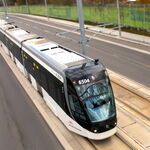Having said all that, the economics of a self-driving LRT line from the CN Milton Terminal to the Bramalea Milton Terminal, passing through or close to all the most important logistics sites in Halton-Peel, perhaps looping through Pearson Airport, and thereby the cost savings of road construction and maintenance, carbon savings, and labour for all those container bearing trucks.... it's less pie in the sky than one might think. People aren't the only thing we need non-road infrastructure for.
- Paul





